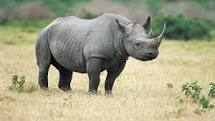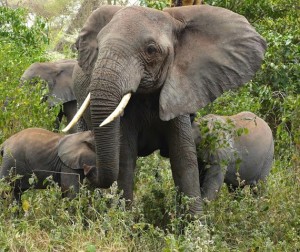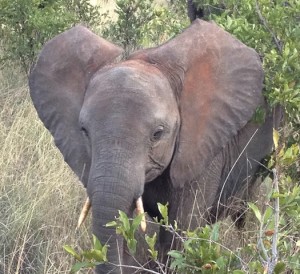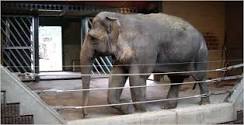
African animals have many challenges, foremost of which is habitat loss and human population growth. Rhinos and elephants have a more immediate challenge–the price of horns.

We saw 4 black rhinos in Ngorongoro but they were too distant to photograph. This is a ‘net photo, which may be the closest we get to seeing a real rhino in a few years.
Today Tanzania has about 35 rhinos; an estimated 850,000 roamed the central/east African plains in the early 1900’s. In 2012, Tanzania counted about 70,000 elephants (¼ or so of all African elephants) which might lead one to think that elephants are doing better–until one hears a government official estimate 30 elephants are being killed each day (10,000/year). Aerial surveys of Selous National Park lands in southern Tanzania, Africa’s largest protected area, found 55,000 elephants in 2007; last year, the number was 13,400.
You should plan your safari soon if you want to see rhinos and elephants in the wild.

Female elephant tusks, though smaller than males, are worth killing for in the poacher calculus. This leaves many young elephants as orphans. Wildlife conservation organizations are setting up orphanages for their care. Photo by Beth V.
The economics are straightforward: ground rhino horn sells for $10,000/pound retail in China and Southeast Asia, where it is revered for presumed medicinal properties. Uncarved ivory sells for $1,500 – $3,000/pound retail, and an average elephant tusk—2 per elephant—weighs 25 pounds. Meanwhile, annual income of a typical tribal household is widely quoted as $360/year. That may be an under-estimate but the stark contrast remains. To take the comparison further, a Tanzanian park ranger makes around $2,500/year. While a hunter/poacher clearly receives only a fraction of the retail value ($100/pound according to some accounts), the incentive to hunt is high. How do you tell an African villager he can’t feed his family? Or buy a motorcycle?

Even small tusks like these are worth a dead elephant. Recent cases show African poachers indiscriminately poisoning 30 elephants at a time by rolling pumpkins laced with cyanide into a herd.
The economics are similar to producing coca in Bolivia or poppy in Afghanistan and, indeed, powerful Asian criminal syndicates have grown up around the horn trade. Rumors abound that the son of Tanzania’s president has enriched himself through the ivory trade. Corruption among port officials is known to be rampant. Al-Shabaab and other terrorist groups are actively involving themselves in ivory to finance their operations. And in the Congo, army units have been found moonlighting as elephant hunters using helicopters and government-issued weapons. Loyal park rangers frequently find themselves seriously outgunned when they encounter poachers.
Is there a solution? Can market demand be stanched? Rhino horn, it turns out, is largely composed of keratin—the main component of fingernails and animal hooves. As one scientist says, if you believe it cures cancer or relieves your hangover, just chew on your fingernails! An obvious and inexpensive solution would seem to be to flood the market with synthetic, cheap “rhino horn” medications.
Ivory demand could be tougher to stem and would seem to depend on educating would-be consumers as to the threat to elephants’ survival. Ivory is a singular material that has been coveted by Asians for centuries. It’s luster, durability and workability have made it a favorite source material for artists. Demand now extends throughout the world, and it will require a serious act of will and cooperation by the governments of many nations to turn the tide. Short of that, your best bet to see an elephant in 20 years will likely be at your local zoo.





You ‘hear’ about this all the time but when you put it into words and read about it–it makes me sad.